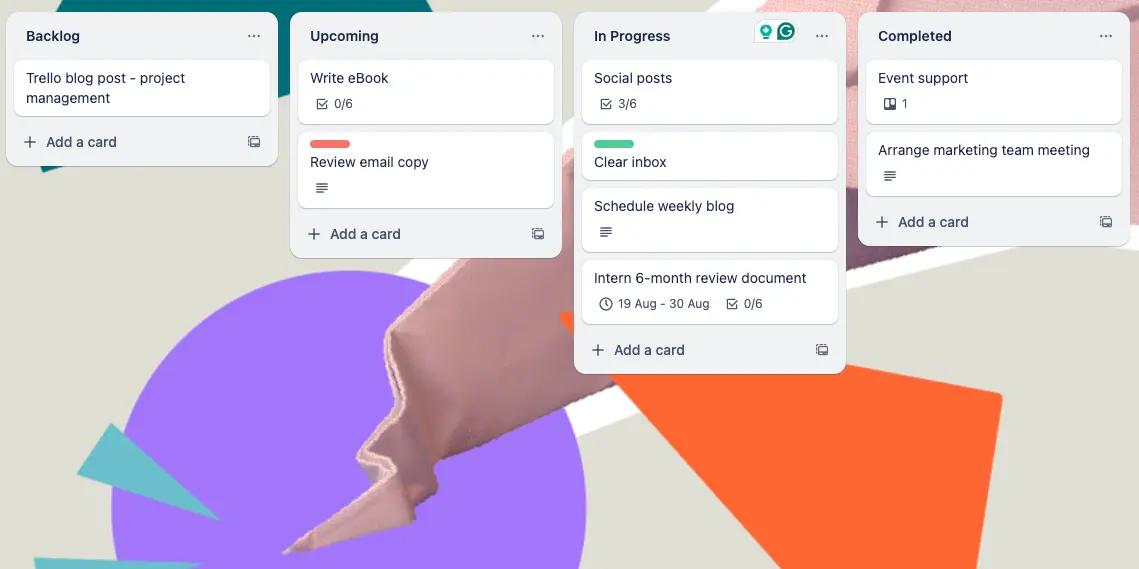Scrum vs Kanban compared: which approach is right for you?
Share on socials
Scrum vs Kanban compared: which approach is right for you?

Jump to Section
Jump to section
What is agile project management?
What is Scrum?
When should I use the Scrum approach?
What is Kanban?
When should I use the Kanban approach?
Scrum vs Kanban - the key differences
Using Kanban with Scrum
Going head-to-head, we’ve got two agile project management approaches: Scrum vs Kanban. Learn more about what they are, and which is right for your team.
Scrum and Kanban are both agile approaches to project management - but what exactly are they, and how can they help you? Let’s talk about it.
And if you’re left inspired to look for more ideas about how to manage your projects, check out our guide on how to use Trello for project management.
And if you’re left inspired to look for more ideas about how to manage your projects, check out our guide on how to use Trello for project management.
What is agile project management?
Unlike the rigid approach to project management (known as the ‘waterfall’ approach), agile project management doesn't follow a linear structure for working. It's an iterative process, meaning things are worked on again and again in response to feedback.
The different aspects of agile project management are:
The different aspects of agile project management are:
- Division of tasks - the project is split into smaller tasks, which are worked on one at a time.
- Teamwork - everyone on the team has specific roles and works together to complete each small task. Teams have regular meetings to check in, share updates, and solve any problems that come up.
- Flexibility - if something isn't working or needs to be changed, teams can adjust plans as they go. This makes it easier to handle any setbacks or new ideas.
- Focus on feedback - after each smaller section of the project is completed, teams use feedback from customers or testers to make improvements.
- Continuous improvement - teams continue to work on the same aspect of the project until all feedback has been implemented to make that part of the project the best it can be.
Agile project management puts the focus on making the product work for the customer, rather than getting the project finished in time for a rigid deadline.
What is Scrum?
Working with the Scrum methodology, a team works in ‘sprints’.
A sprint is a short, fixed period (usually 2-4 weeks) during which the team works on a set of tasks for the project. The goal is to complete something that can be shown or used by the end of the sprint.
When using the Scrum approach, teams are split into three roles (not to be confused with job titles) - these are Product Owner, Scrum Master, and Development Team.
To learn more, read our guide: What is Scrum?
A sprint is a short, fixed period (usually 2-4 weeks) during which the team works on a set of tasks for the project. The goal is to complete something that can be shown or used by the end of the sprint.
When using the Scrum approach, teams are split into three roles (not to be confused with job titles) - these are Product Owner, Scrum Master, and Development Team.
To learn more, read our guide: What is Scrum?
When should I use the Scrum approach?
While Scrum is mostly associated with software development projects, these are far from the only types of projects that can benefit from this approach.
Your team should consider using Scrum if:
Your team should consider using Scrum if:
- The project is complex and requirements might change over time. If it’s difficult to define a clear, detailed plan from the beginning, Scrum can help your team to focus on one aspect of the project at a time.
- Customers are at the centre of what you want to achieve. Consider using Scrum when the project requires constant validation and alignment with user needs.
- You want team members with different skills to collaborate closely. Scrum methodology encourages team members to work both in areas that they’re used to working in, and giving their input on other aspects of the project like development, testing, and design.
- You want to boost productivity. Working in short iterations means team members don’t have to spread their focus across different work items, and prevents burnout and boredom.
- You want to give team members the opportunity to manage their own work. The Scrum approach asks that the team plan, execute, and review their work with minimal external direction.
- You’re striving for continuous improvement. If creating the best product for customers is more important to you than a one-and done project, Scrum is for you.
- You want your project progress to be transparent. Scrum facilitates clear visibility of progress, challenges, and achievements, for both stakeholders and customers.
What is Kanban?
Kanban is a visual way to see and organise your tasks. Its process centres around a smooth workflow with little to no roadblocks. It uses a Kanban board that has Kanban cards placed on it. The board (and cards) can be physical and created by hand, or you can use an app to create it digitally. We recommend using an app like Trello for great team communication.

Trello is an app that lets you create simple but customisable Kanban boards
With Kanban, there are no roles - everyone on the team is an equal, and can put their skills to use on any of the available tasks.
Learn more with our guide: What is Kanban?
Learn more with our guide: What is Kanban?
When should I use the Kanban approach?
Your team should consider using Kanban if:
- You want something more visual and dynamic than a typical to-do list. A Kanban board is more interesting and informative to look at than your usual list of tasks - and you benefit from being able to move tasks around based on their status.
- You want to avoid getting stuck on tasks - and save time doing it. By taking the time to identify chains of tasks (tasks that are dependent on the completion of other tasks), you can smartly prioritise what needs to be done.
- You’re keen to boost collaboration and swap skills. Because there are no set rules, the Kanban board is your playground. Use skills you don’t usually get the chance to and help someone else or try something new.
- You want to provide visibility on what everyone is up to. With Kanban you can easily see the progress of the project and what’s being worked on, by who.
Scrum vs Kanban - the key differences
| Scrum | Kanban | |
|---|---|---|
| Principles | Continuous learning and improvement, self-organising, reflection and reviewing | Visual task lists and progress, collaboration |
| Roles | Product Owner, Scrum Master, Development Team | No roles - working outside usual role encouraged |
| Workflow | Working on one aspect of the project in short sprints (2-4 weeks) | Continuous workflow based on prioritisation of tasks |
| Practices | Sprint planning, sprints, stand-up meetings, sprint reviews, sprint reflections | Limiting the number of in-progress tasks, working outside of usual roles, prioritising individual tasks |
| Meetings | Regular - typically daily | Not required, but recommended to have meetings to check in |
Using Kanban with Scrum
If you like the look of both approaches, there’s no need to choose. Kanban can work hand-in-hand with Scrum to provide a holistic work practice that combines visuals and focused work management.
Power up your projects with our range of guides
Written by

Senior Content Marketing Manager
As an experienced content marketer and a long-time Confluence user, Hols is passionate about creating educational, accessible guides that help readers go beyond the limitations of their Confluence instance.



